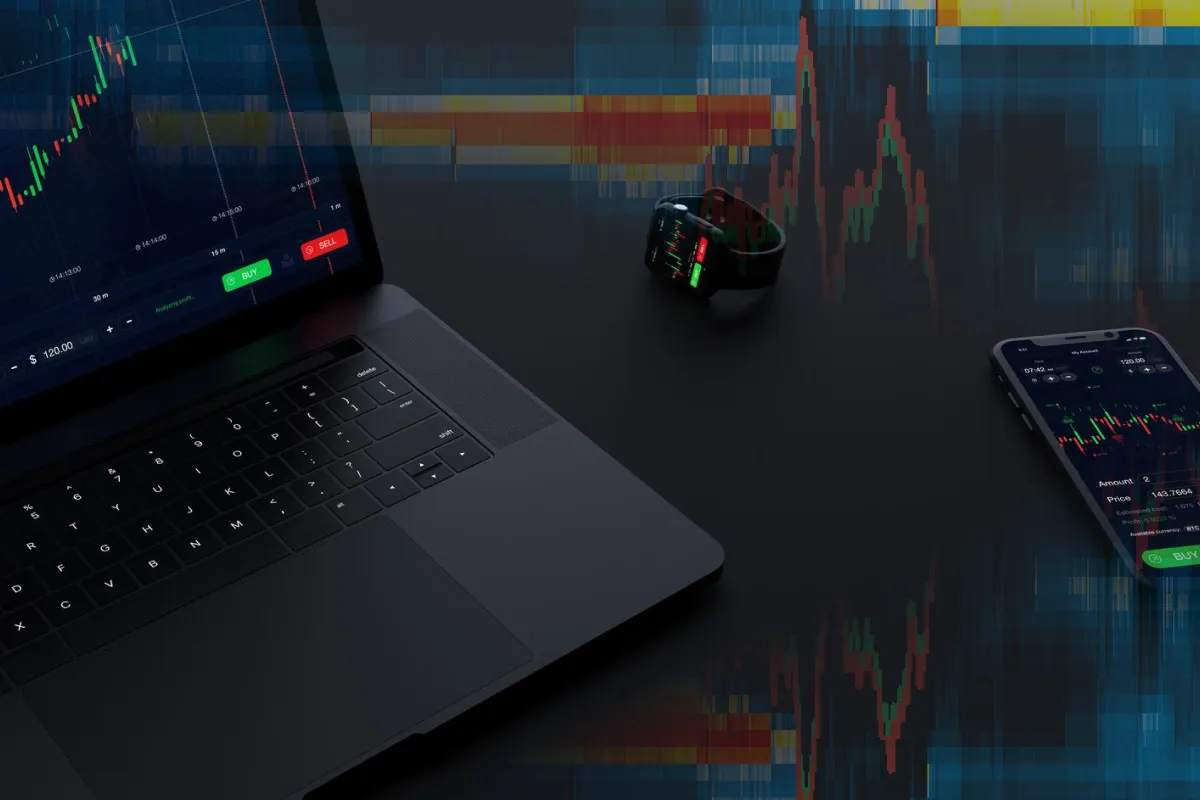

December Trading
Deals Are Live!
Save on Global+, data access,
and add-ons.
See All December Deals
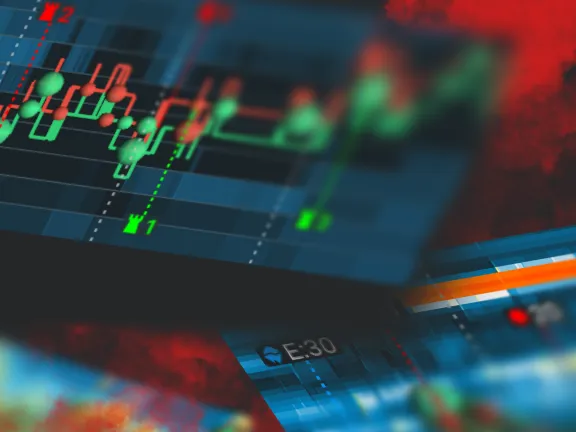
Black Friday
Nov 28-Dec 31
23 days : 16 hours
50% OFF Global+ Quarterly
+ 50% OFF Data (3 months)

Cyber Monday
Dec 1 - Dec 31
23 days : 16 hours
60% OFF Global+ Monthly
+ Data (1 month)
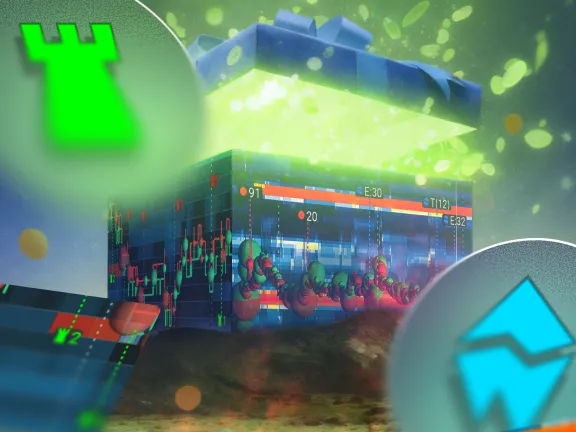
Add-on Deals
Dec 1 - Dec 31
23 days : 16 hours
50% OFF
Add-ons

New Year Sale
Dec 26 - Jan 1
17 days : 16 hours
30% OFF Global+ Lifetime
*Data not included
Education
September 13, 2024
SHARE
Essential Trading Glossary Terms Used in Bookmap: A Comprehensive Guide
Knowledge isn’t just an advantage. It’s the key to success. This adage rings truer than ever in the financial markets. By having a strong understanding of market dynamics, you can manage risks effectively and spot profitable opportunities. Moreover, to gain a competitive advantage, you can start using advanced market analysis tools such as Bookmap.
In this article, we will explain the major trading terms in Bookmap, such as absorption, aggressor volume, and iceberg orders. Also, you will learn about critical market signals, such as potential price reversals and hidden order sizes. Additionally, you will understand about different views like Market-By-Price (MBP) and Market-By-Order (MBO).
Lastly, we will cover risk management tools, such as stop orders and bracket orders, which help protect your investments and maximize profits. Let’s begin!
Absorption
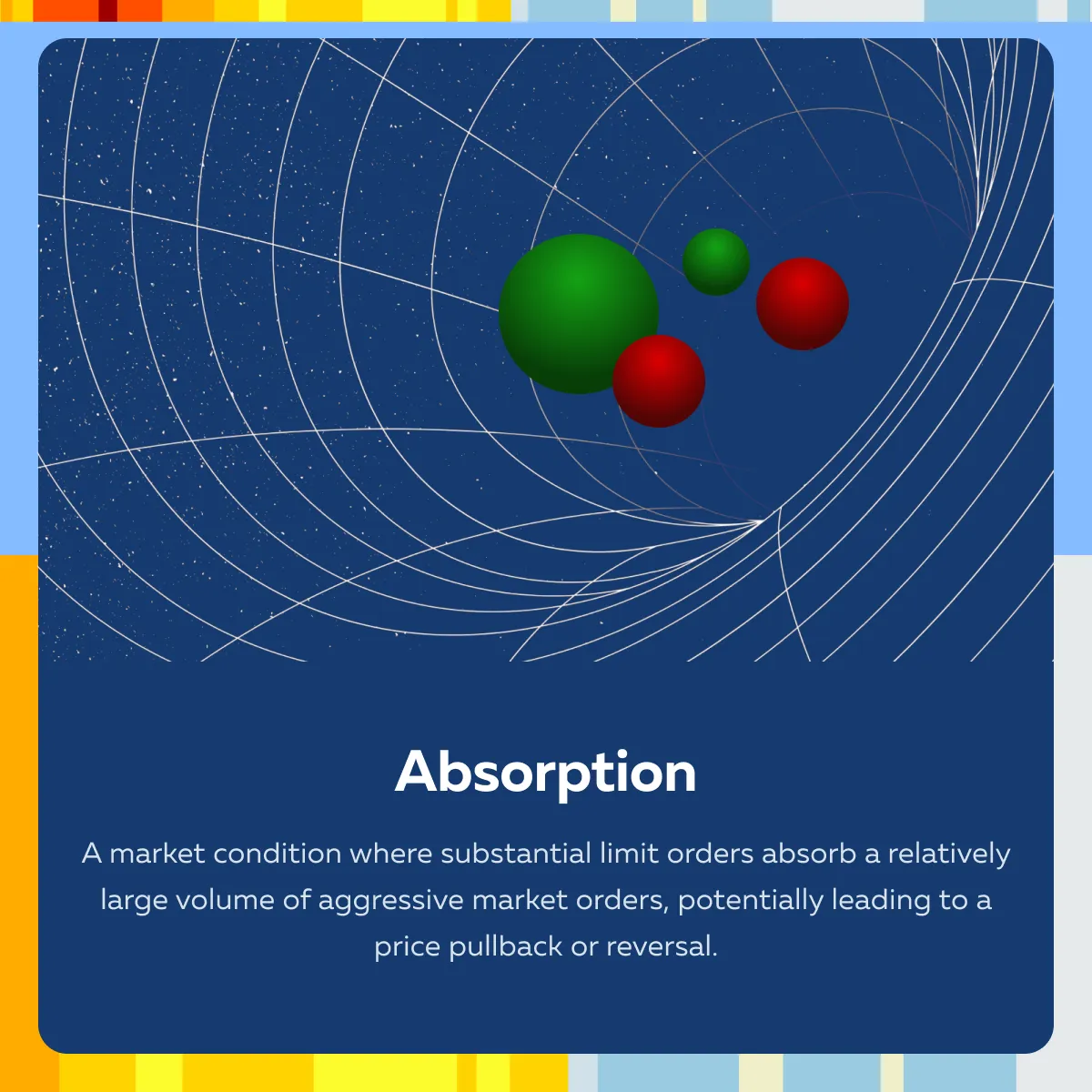
Absorption in trading happens when large limit orders absorb a significant number of market orders (which are executed immediately).
Traders can identify absorption by watching the order book, where they’ll see large buy or sell orders that don’t quickly disappear despite many trades against them. This suggests that strong buyers or sellers are holding their ground. When this happens, it indicates a possible price reversal because the aggressive side (buyers or sellers) may be running out of momentum. Traders can use this signal to anticipate and react to potential price changes.
Aggregate Data
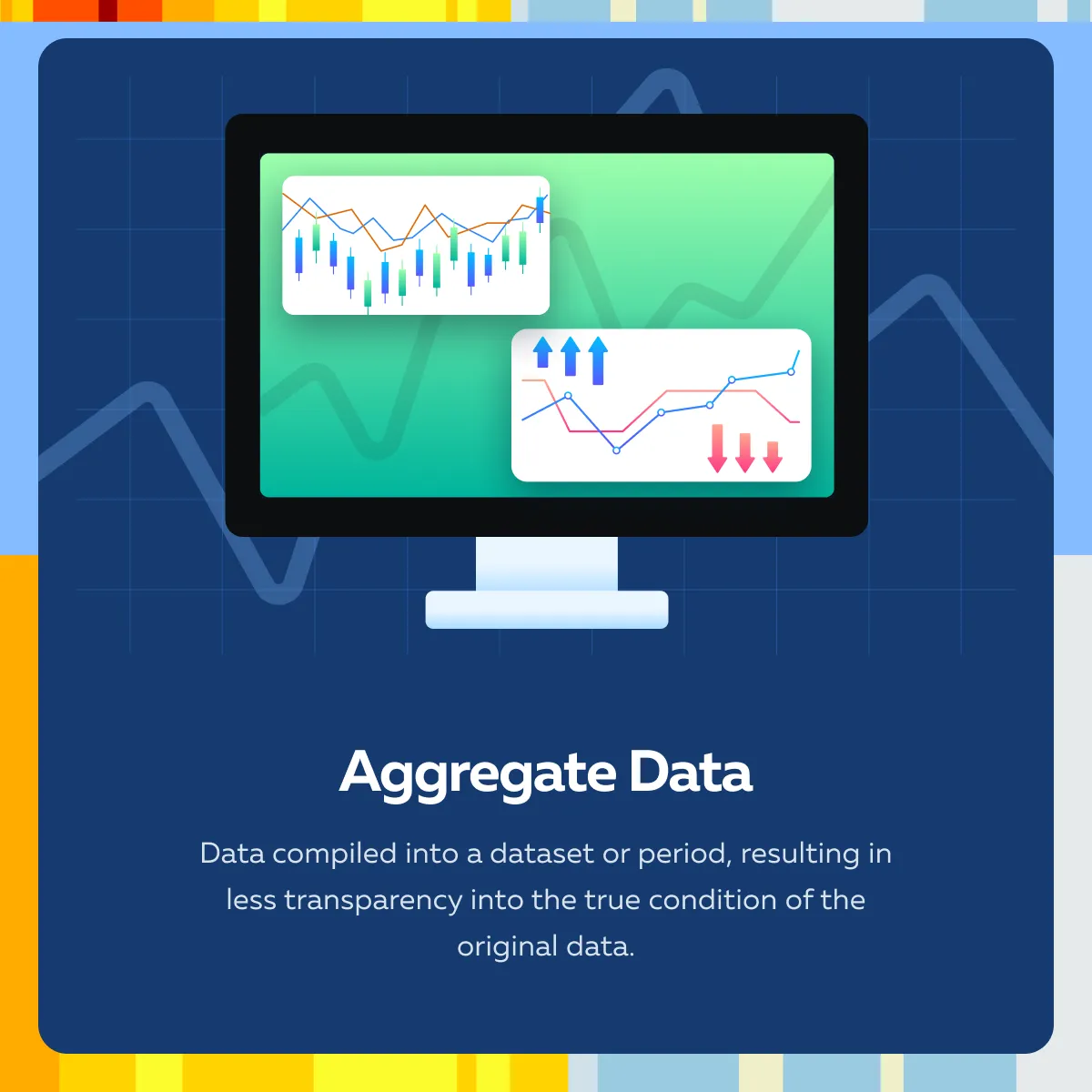
Aggregate data combines individual pieces of information into a single summary, which can hide important details.
For example:
- Suppose daily trading volumes are averaged over a week.
- Now, assume that a trader misses a sudden spike in volume on a particular day.
- This spike indicates strong buying or selling pressure and signals potential price movement.
However, because the data is aggregated, the spike is smoothed out, making it harder to spot. As a result, the trader misses critical clues that could influence their decisions, such as reacting to a surge in market interest or activity.
Aggressor Volume
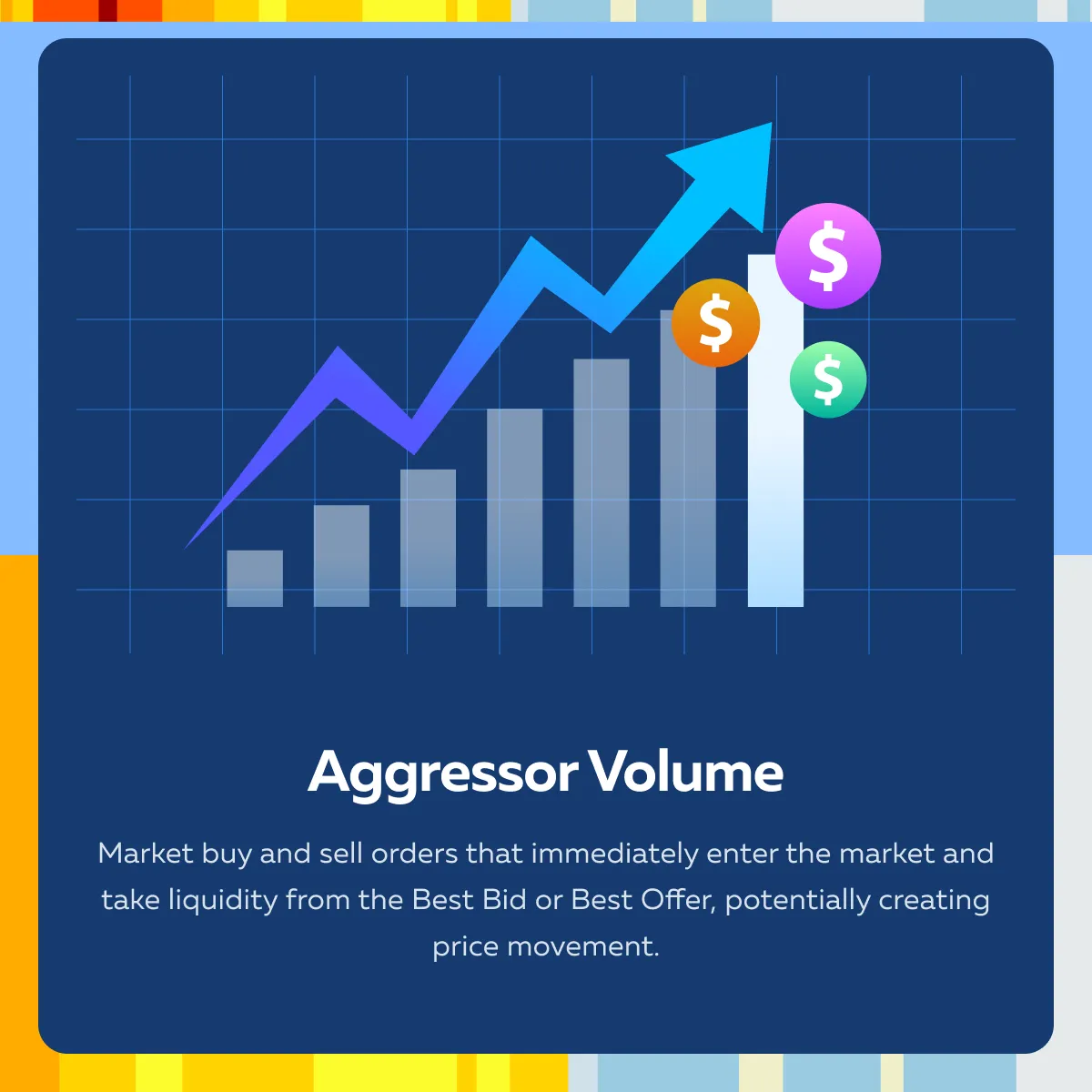
Aggressor volume refers to market orders that are executed immediately after taking available liquidity at the current:
- Best bid (buy)
or
- Best offer (sell) prices.
It must be noted that when there is a high aggressor volume on the buy side, it indicates strong buying pressure. This often leads to price increases as buyers quickly consume available sell orders. At the same time, high aggressor volume on the sell side shows strong selling pressure, which usually drives prices down as sellers quickly hit the bids. Most traders monitor aggressor volume to spot market sentiment and predict the expected price movements.
Book Sweep
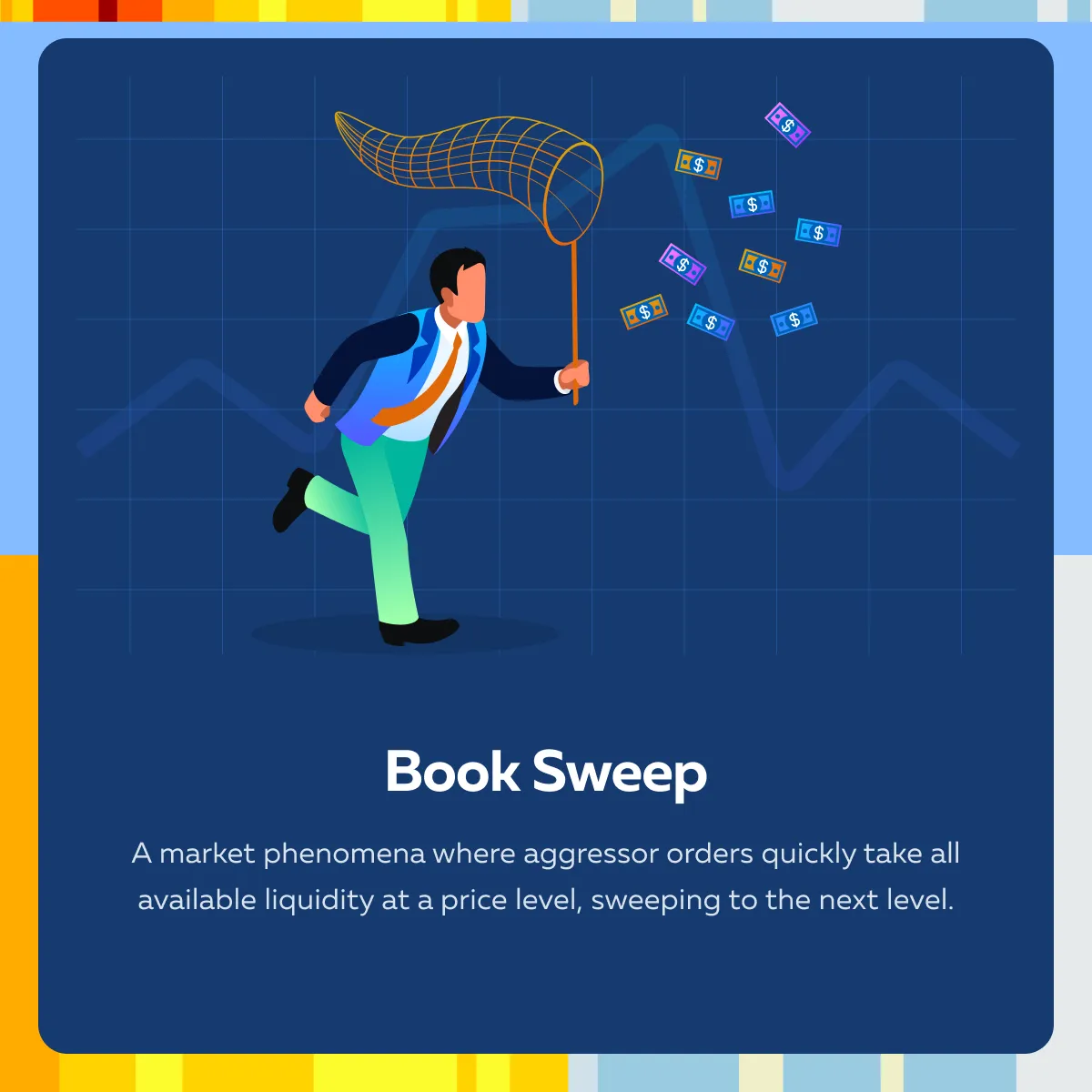
A book sweep occurs when a large market order rapidly consumes all available buy or sell orders at the current price level, pushing the price to the next level.
For example:
- Say a trader places a massive buy order.
- They quickly buy all available shares at $100, then $101, and so on, until the order is filled.
- This causes the price to jump rapidly.
It is worth mentioning that for traders, a book sweep makes it difficult to enter or exit positions at their desired price. That’s because the sudden price movement leads to slippage, where they end up trading at a less favorable price than intended.
Bracket Order
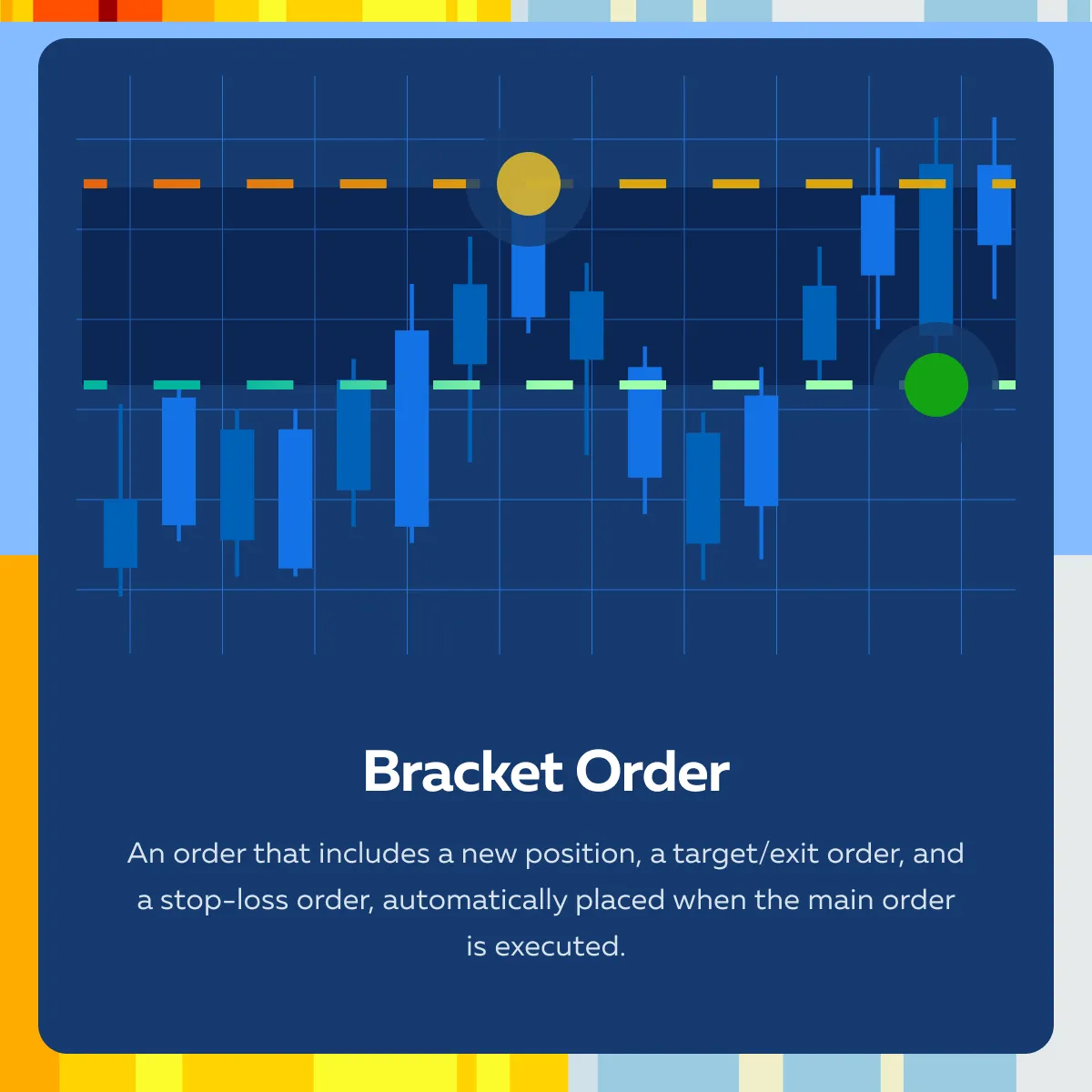
A bracket order helps traders manage risk and secure profits by automating their trading strategy. When a trader places a bracket order, it includes three components:
- The main order to enter a position,
- A target/exit order to take profits at a certain level, and
- A stop-loss order to limit potential losses.
Once the main order is executed, the target and stop-loss orders are automatically activated. If the price reaches the target, the position is sold for a profit. Conversely, if it hits the stop-loss, the position is sold to minimize losses. This setup allows traders to manage trades without constant monitoring.
Dangling or Smoking
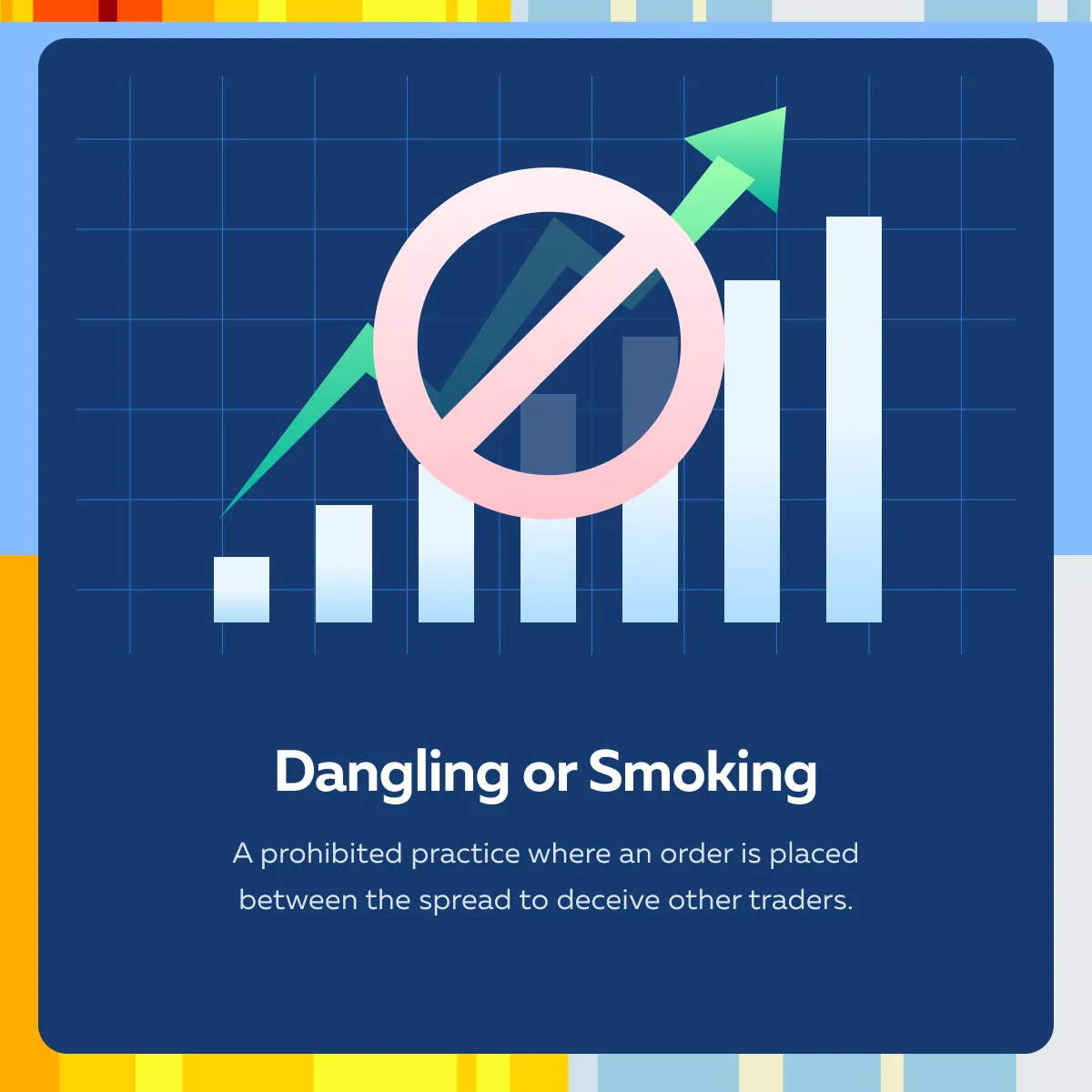
Dangling, or smoking is a deceptive trading tactic. Following it, a trader places an order between the bid and ask prices (the spread) to create a false impression of market interest.
For example:
- A trader places a large buy order just below the ask price.
- Such a placement tricks others into thinking there’s strong buying pressure.
- This encourages other traders to buy at a higher price.
- Once the market reacts, the deceiving trader cancels the order and profits from the price movement.
- This manipulation distorts the true supply and demand.
- It leads to unfair trading conditions and is banned in most markets because it misleads other traders.
Dark Pools

Dark pools are private trading venues where large orders can be executed without publicly revealing the trade details. The advantage of dark pools is that they allow institutional investors to buy or sell large quantities of assets without causing significant market impact. This way, institutional investors can avoid price fluctuations that might occur if these trades are done on a public exchange.
Nevertheless, the absence of transparency in dark pools poses risks. This happens because other traders can’t see the order flow, which makes it harder to gauge true market conditions. This lack of visibility leads to a less transparent and less efficient market, where price discovery is potentially distorted.
Depth of Market (DOM)
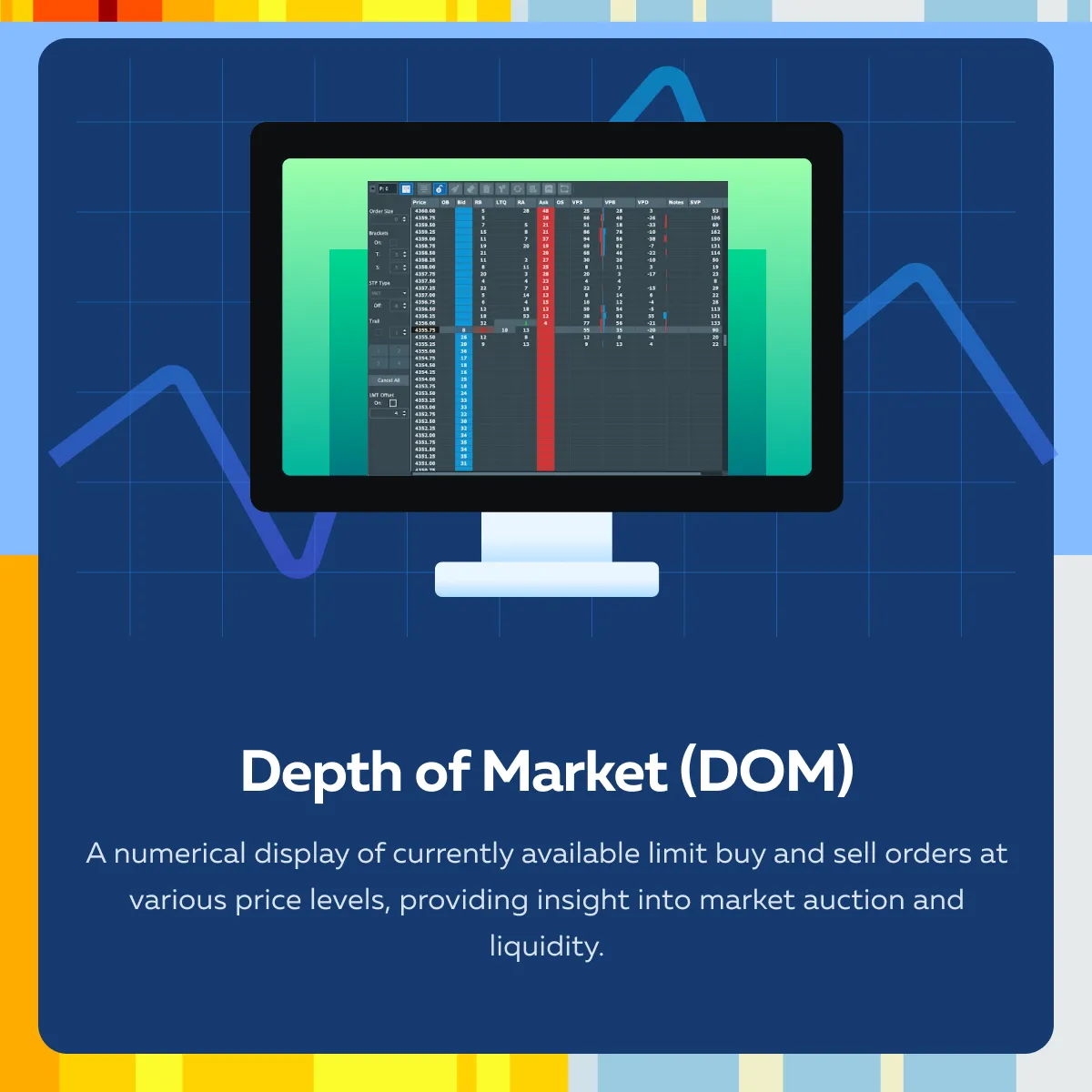
Depth of Market (DOM) displays the number of buy and sell limit orders at different price levels. DOM helps traders assess market sentiment and liquidity. By analyzing DOM, traders can see where the bulk of buy and sell orders are placed.
For example:
- Say there exists a high concentration of buy orders at a particular price level.
- Now, this might indicate strong support and suggests that the price is unlikely to fall below that level.
- On the other hand, a cluster of sell orders can signal resistance.
Most traders use this information to decide their entry and exit points and to anticipate potential price movements.
Do you wish to get real-time visualizations of DOM? Enhance your trading strategies with Bookmap’s advanced tools. Sign up today!
Flipping
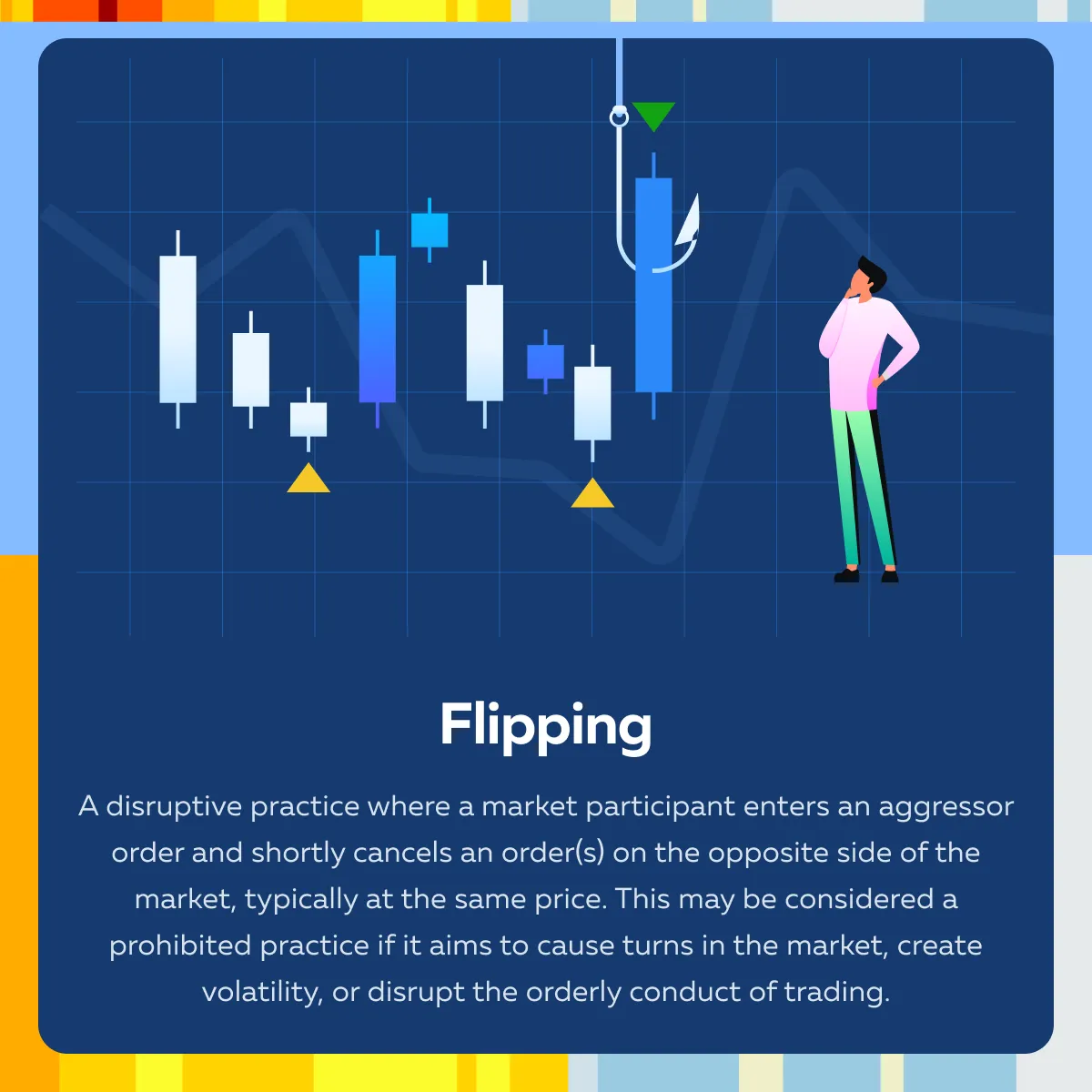
Flipping involves placing an aggressive order (e.g., a large buy order) and then quickly canceling an opposite order (e.g., a sell order) at the same price.
For example:
- A trader places a big buy order to push the price up.
- Then, they immediately cancel a sell order.
- This way, they make it look like there’s strong buying interest.
- Other traders react to this manipulation, which drives the price higher.
- The trader then sells at the inflated price for a profit.
In this manner, flipping disrupts market stability. It creates artificial volatility and misleads other participants. Due to its manipulative nature, flipping is often prohibited in regulated markets.
Iceberg Order (Hidden Order)
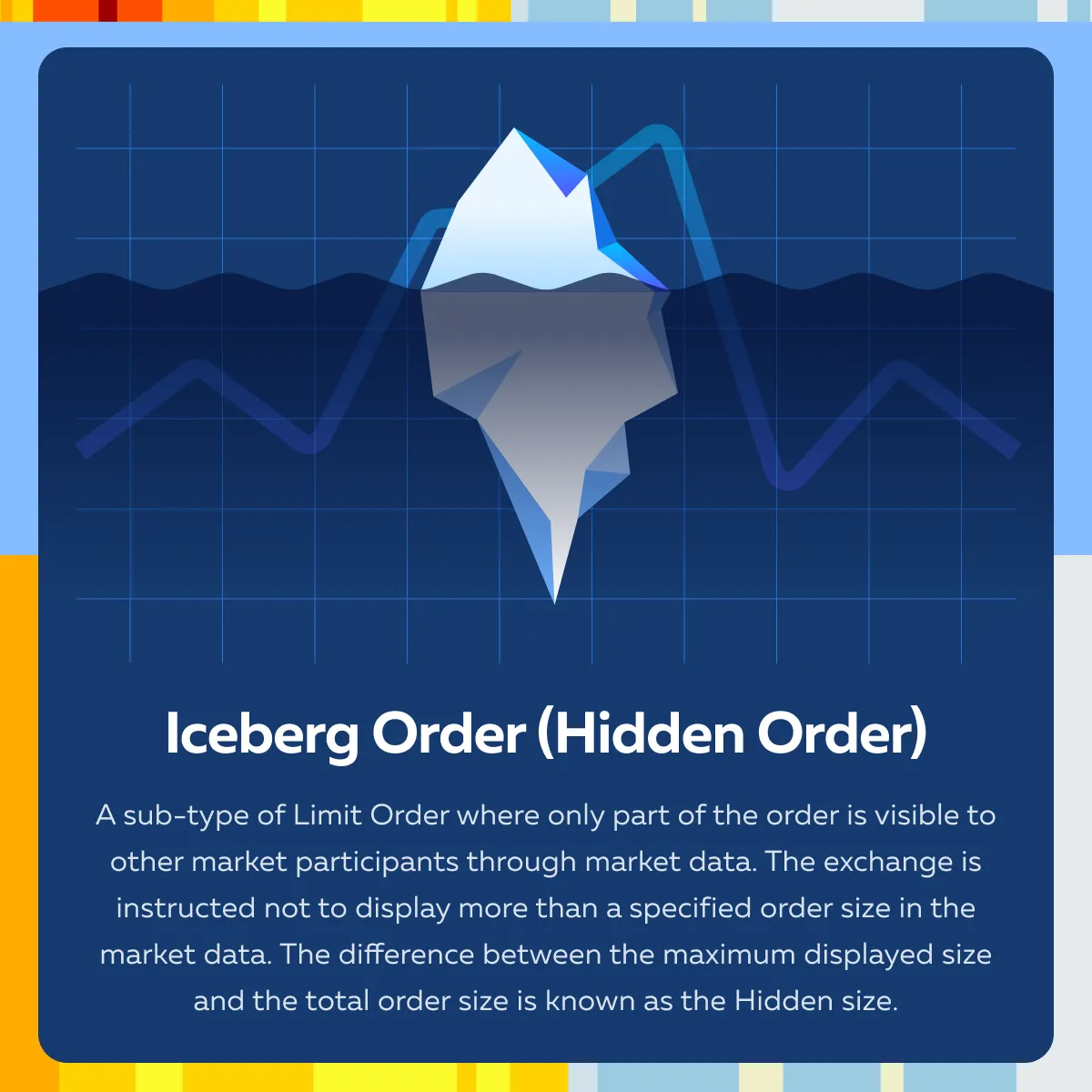
An iceberg order allows traders to hide the full size of their order by only showing a small portion of it to the market.
For example:
- A trader wants to sell 10,000 shares.
- They set an iceberg order to display only 500 shares at a time.
- As the visible portion gets filled, the next 500 shares automatically appear, and so on, until the full order is completed.
- This strategy helps traders avoid large price movements that could occur if the market saw the entire order at once.
This way, by minimizing the visible order size, traders execute large trades more discreetly without significantly impacting the market price.
Native Iceberg Order
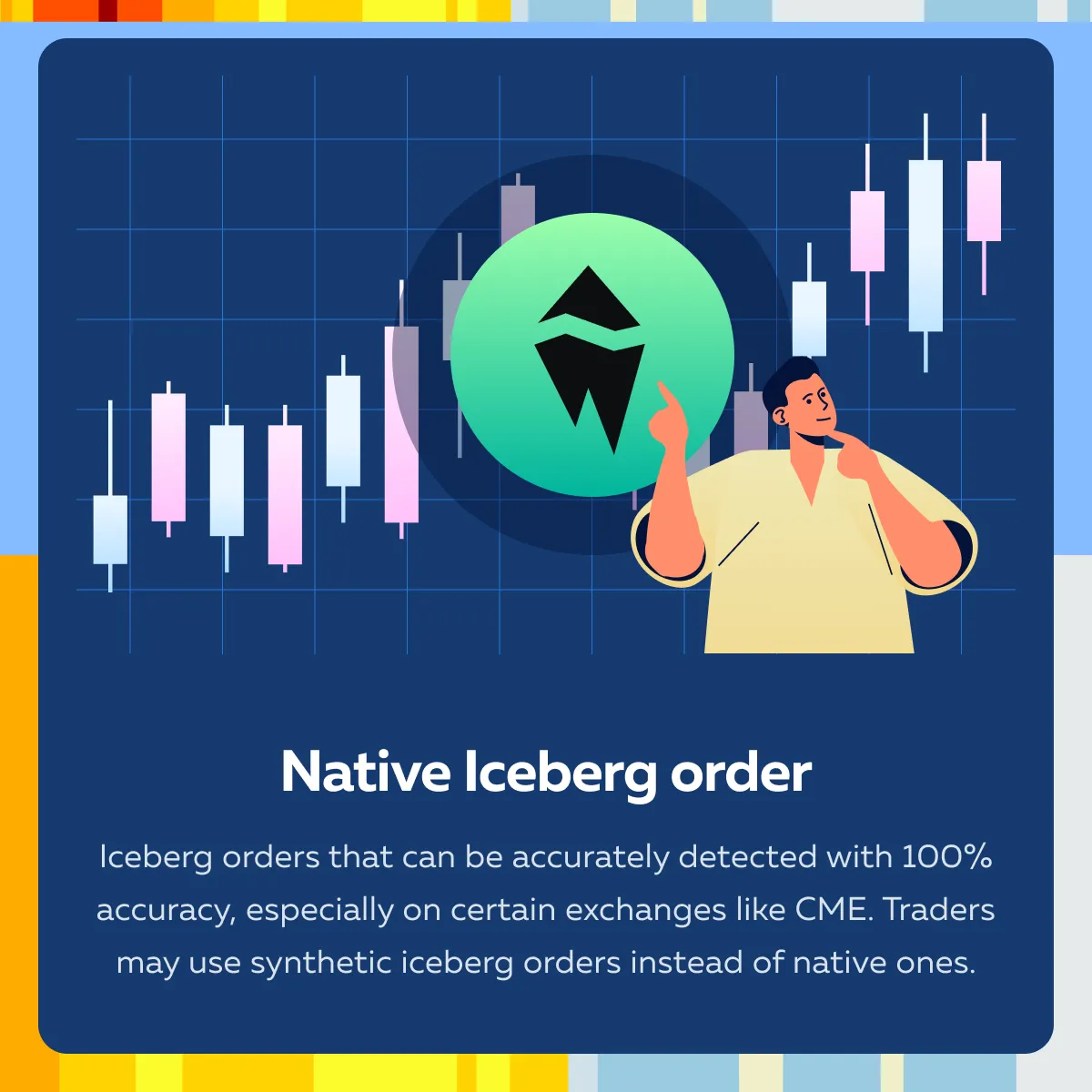
Native iceberg orders are special orders used in high-frequency trading, particularly on exchanges like the CME. They permit traders to conceal the actual size of their orders by only showing a minor portion at a time.
The advantage is that it prevents other traders from knowing the full order size, which reduces the chance of market impact. This strategy aids high-frequency traders to execute large orders without significantly moving the market.
Notably, these orders are built into the exchange, making them more efficient and harder to detect. By placing them, traders often gain a competitive edge.
Synthetic / Heuristic Iceberg Order

Synthetic iceberg orders are regular limit orders. They are mostly used by high-frequency traders (HFT) to mimic the behavior of native iceberg orders. Unlike native iceberg orders, which are directly supported by the exchange, synthetic orders are split and executed in small portions by the trading algorithms.
Their goal is to hide the true order size and prevent other traders from detecting large trades. This strategy helps traders execute large orders without causing significant market movement.
With Bookmap, you can easily detect iceberg orders by visualizing hidden order sizes and spotting patterns that indicate large, concealed trades. Optimize your trading strategies with Bookmap’s tools. Get started here!
Ignition
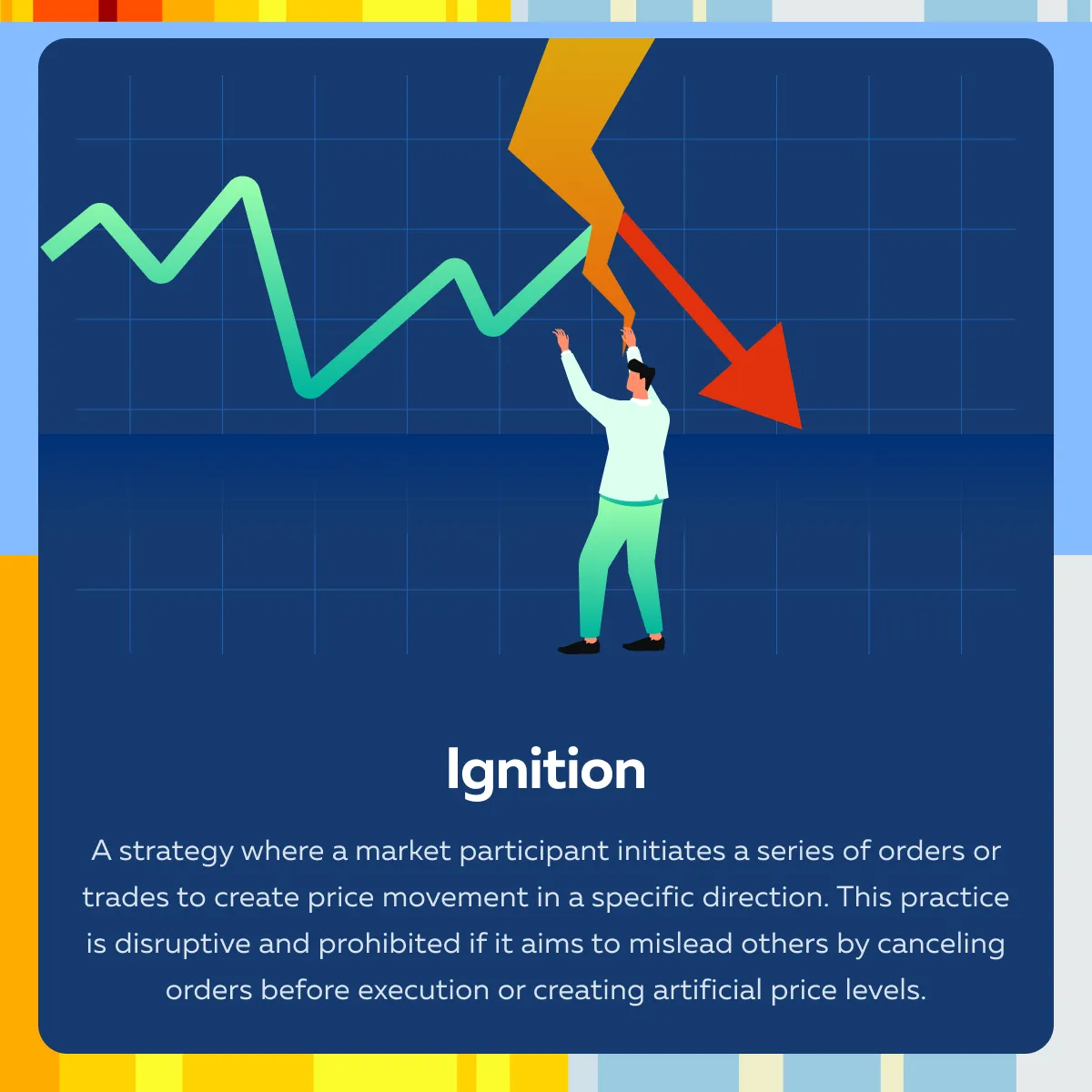
Ignition is a trading strategy where a trader deliberately places orders to move the market price in a specific direction. Here, the intention is to mislead others by:
- Canceling orders before they’re executed
or
- Creating fake price levels.
In most markets, this practice is considered unethical as it manipulates the market and creates a false sense of supply or demand. Also, ignition undermines market fairness and leads to unfair losses or gains for other participants.
Master trading terms with Bookmap – Join now!
Limit Order
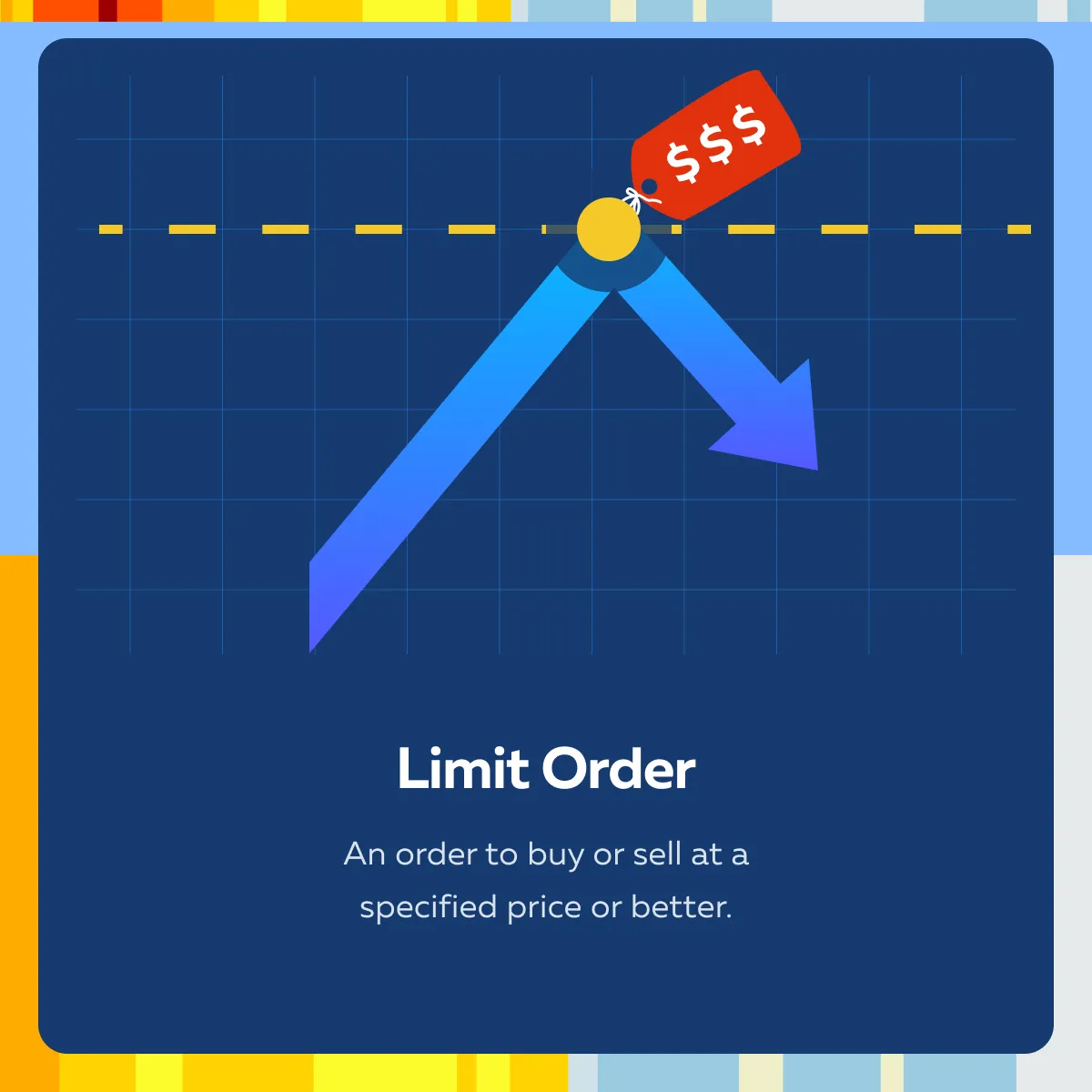
A limit order is an instruction to buy or sell a stock at a specific price or better. For example:
- Say you want to buy a stock that’s currently trading at $100 but only want to pay $95.
- In this case, you can place a limit order at $95.
- The order will only execute if the stock price comes down to $95 or lower.
This strategy is most effective when you want to control the price at which you enter or exit a trade. It is also useful in volatile markets, where prices can fluctuate rapidly.
Lit Pools (Lit Book)

Lit pools, or lit books, are trading venues where all buy and sell orders are publicly displayed on an exchange’s Centralized Limit Order Book. The main benefit of lit pools is transparency. This implies everyone can see the current:
- Orders,
- Prices, and
- Volumes.
This visibility promotes fair competition and accurate price discovery, as all market participants have access to the same information. In contrast, dark pools are private and do not publicly display orders, which usually leads to less transparency and unfair advantages for some traders. Therefore, lit pools contribute to a more open and fair market.
Liquidity
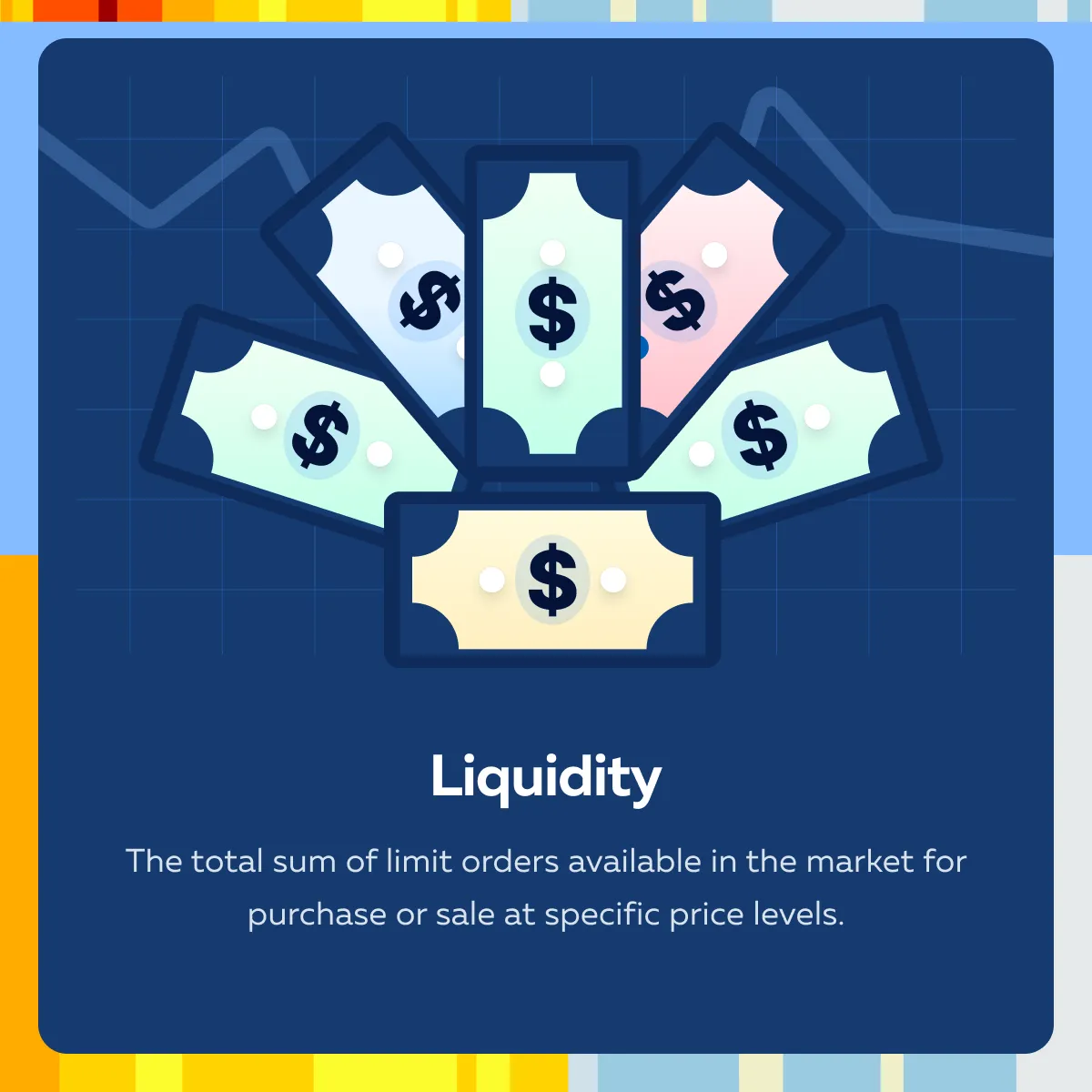
Liquidity refers to the availability of buy and sell orders in the market at various price levels. It is crucial for market stability and efficient trade execution. High liquidity means there are many orders, and traders can buy or sell assets quickly without significantly affecting the price. This lessens the risk of price slippage and guarantees that trades can be executed smoothly.
Low liquidity, in contrast, leads to price volatility and difficulty in executing trades at desired prices. It makes the market less predictable and riskier.
Market Order
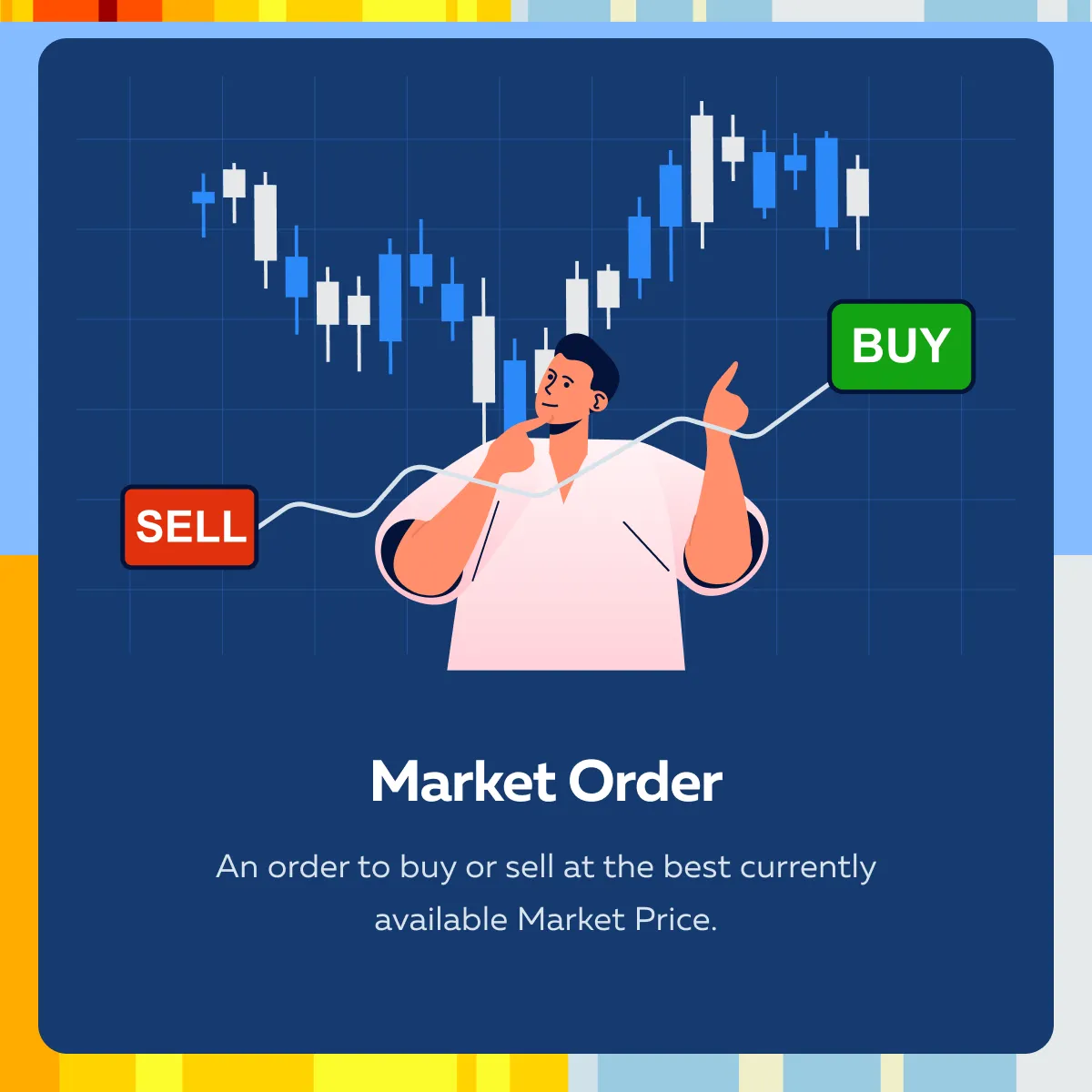
A market order is an instruction to buy or sell an asset immediately at the “best available current market price.”
For example:
- Say you want to quickly purchase shares of a stock that’s rapidly increasing in value.
- Now, you would use a market order to ensure the trade is executed as soon as possible.
It must be noted that market orders are ideal when speed is more important than the exact price, such as when reacting to news or market movements. However, be aware that they may result in paying slightly more or selling for less than expected, especially in volatile markets with rapidly changing prices.
Market-By-Price (MBP)
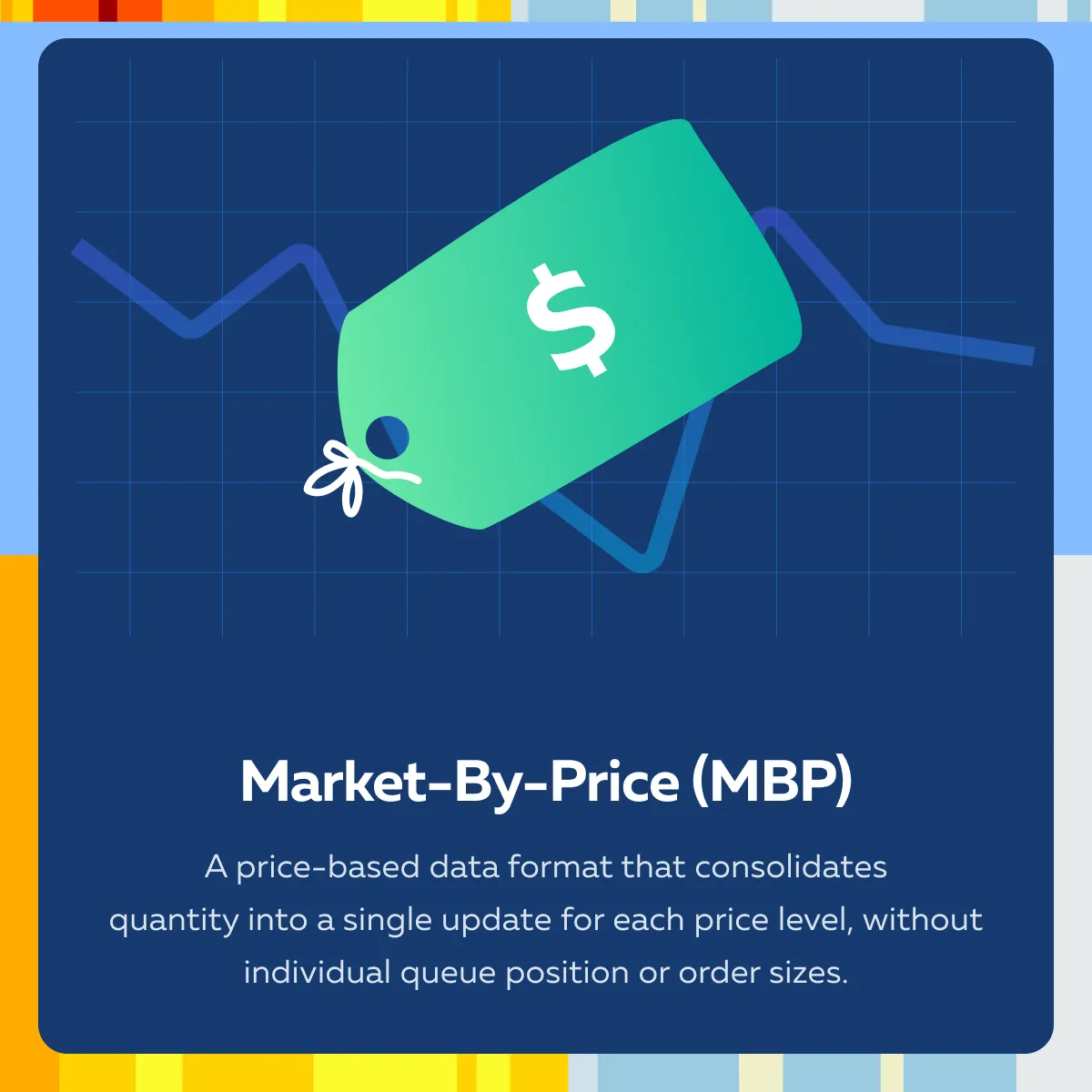
Market-by-price (MBP) provides a simplified view of market depth by consolidating all orders at each price level into a single update. Instead of displaying every individual order, MBP aggregates the total quantity available to buy or sell at that price. This approach offers a clearer picture of how much liquidity exists at various price levels.
This format makes it easier for traders to see the overall supply and demand without getting bogged down by the details of each order’s size or position in the queue.
Market-By-Order (MBO)
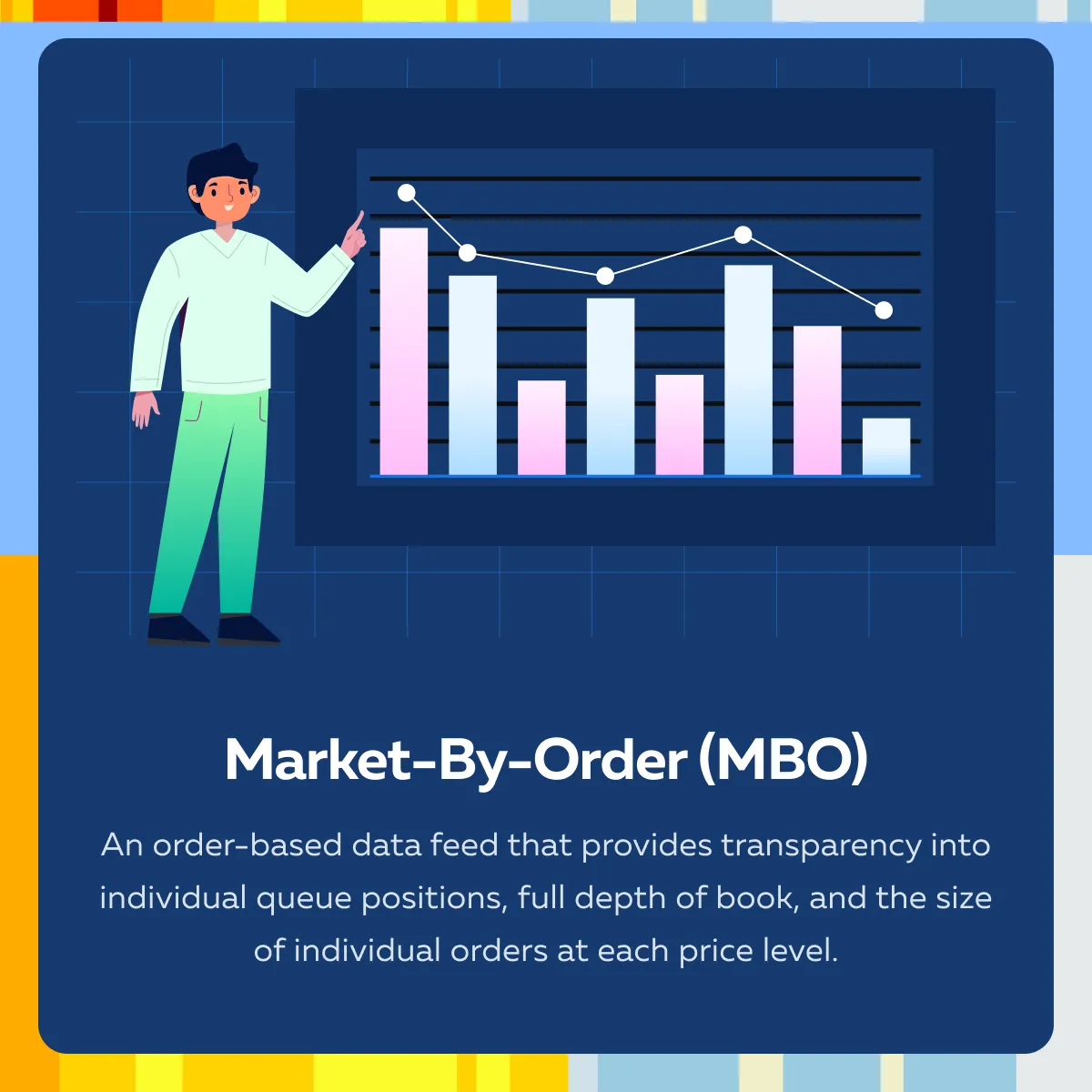
Market-by-order (MBO) offers detailed insights into market dynamics by providing a granular view of the order book. Unlike Market-By-Price (MBP), which aggregates orders at each price level, MBO displays every individual order, including its size and exact position in the queue.
This allows traders to see not only the total liquidity at each price level but also:
- How are orders stacked?
- Which orders are likely to be filled first?
- Which changes happened in the order flow?
This level of detail helps traders better comprehend market movements. Also, they can precisely anticipate price changes and improve their trading strategies.
Spoofing
Spoofing is the practice of placing fake bids or offers in the market with no intention of executing them. These deceptive offers are placed solely to create artificial price movements. This unethical and illegal tactic misleads other traders by giving a false impression of supply or demand.
Usually, the legal implications of spoofing are severe, as it is considered market manipulation and is prohibited by financial regulators. Some negative effects of spoofing are:
- Undermines market integrity,
- Distorts true market conditions,
- Erodes trust, and
- Harms the fairness of financial markets.
Stop Order
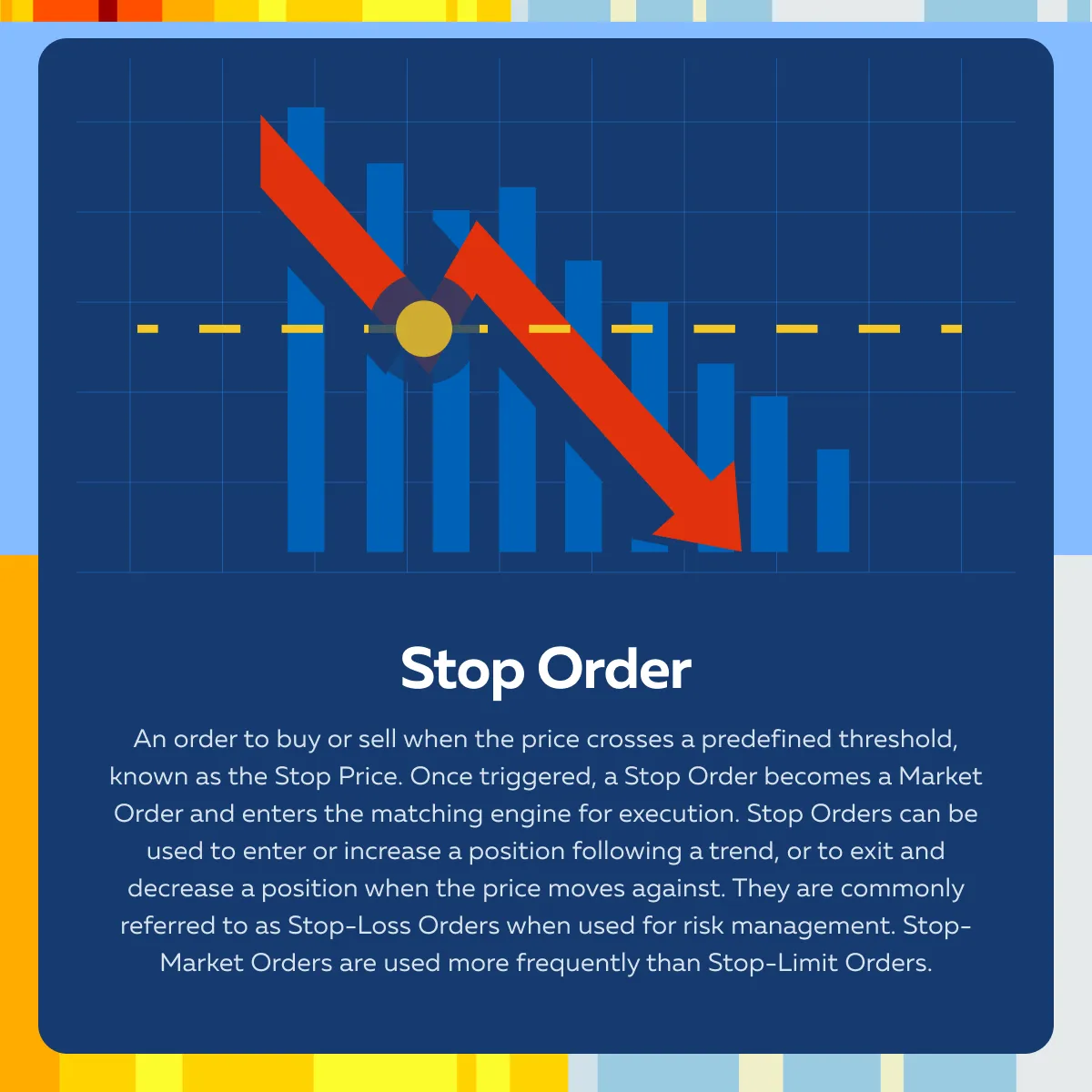
A stop order is a trading tool used to manage risk by triggering a buy or sell action when the price reaches a predefined level called the stop price.
For example:
- Say you own a stock and want to limit potential losses.
- Now, you can set a stop order to sell if the price falls to a certain level.
- This helps protect against further losses if the market moves against you.
Furthermore, stop orders can also be used to enter a position. To do so, traders set a “buy stop order” that triggers when the price rises to a certain level and captures upward trends. This automatic action helps to manage trades based on market movements.
Buy Stop
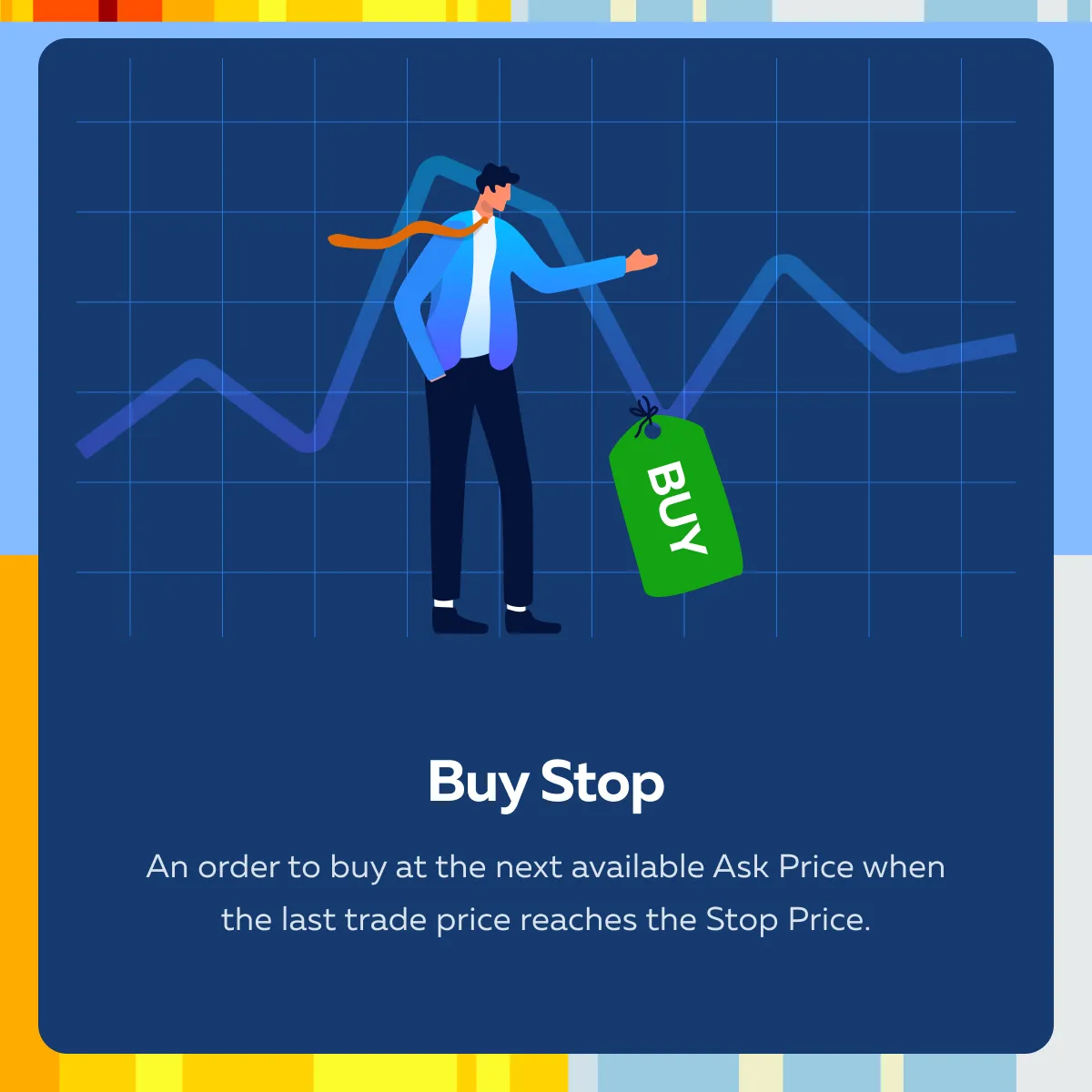
A buy stop order is used to enter a position in a rising market. You always set a stop price above the current market price. Later, when the market price reaches or exceeds this stop price, the buy stop order activates and buys at the next available ask price.
This strategy is useful for traders who want to capture upward momentum by entering a trade only when the price confirms an uptrend. By using a buy stop order, you also avoid buying into a potential false rally or decline.
Sell Stop
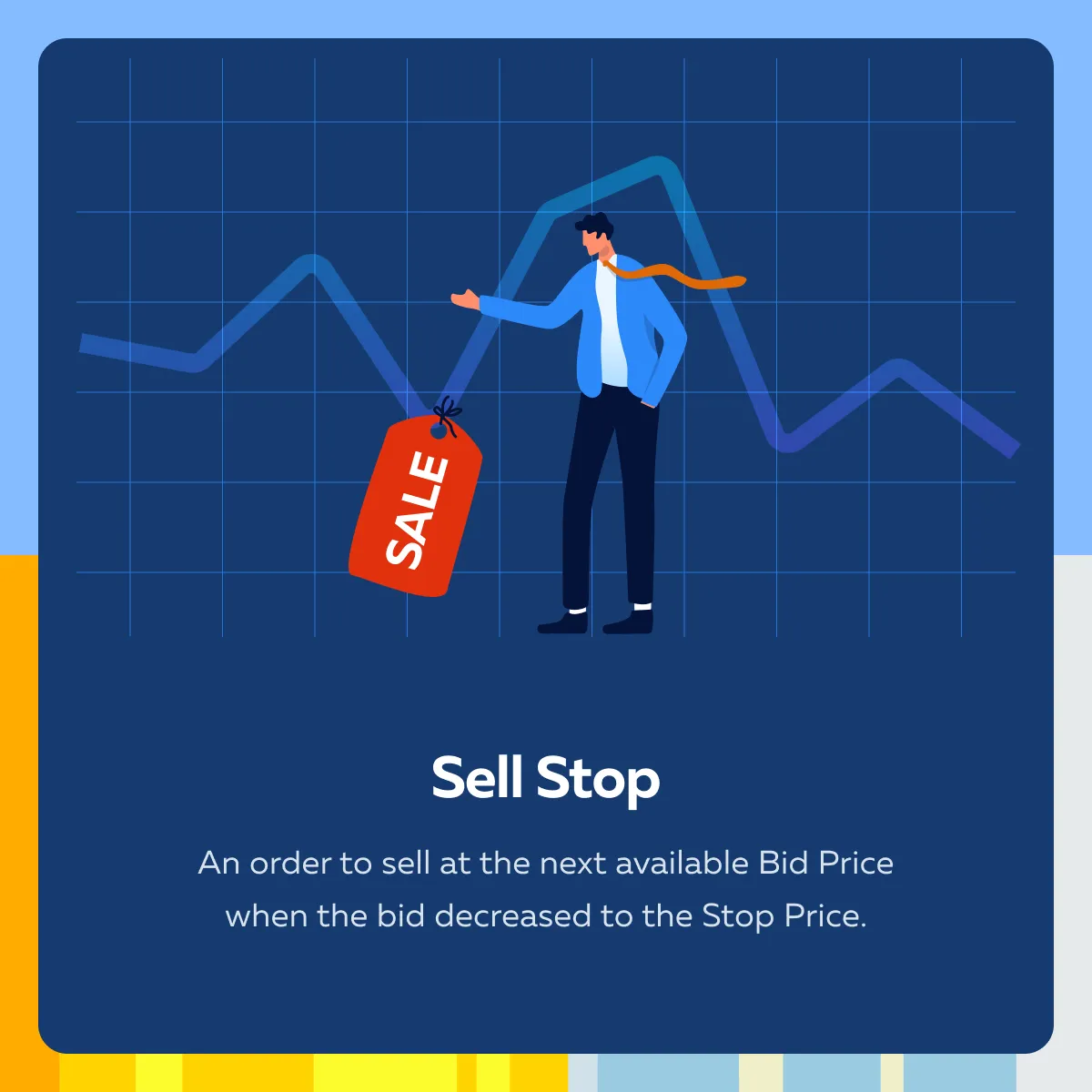
A sell stop order helps traders limit losses in a declining market. By placing this order, a trader can automatically sell an asset when its price drops to a specified stop price.
For example:
- Say you own a stock and set a sell stop order at $50.
- Now, the order will trigger and sell the stock at the next available bid price once the market price falls to $50 or lower.
- This action helps protect against further losses by exiting the position before the price declines further.
By setting a sell stop order, traders can manage their risk and prevent emotional decisions during market downturns.
Conclusion
To use Bookmap effectively and optimize your trading strategies, it is essential to know several trading terms in Bookmap, such as absorption, aggressor volume, and iceberg orders. These concepts help traders make informed decisions by analyzing market depth, liquidity, and order flow.
For example, by recognizing “absorption,” you can spot when the price might change direction. Similarly, by learning the difference between “Market-By-Price” (MBP) and “Market-By-Order” (MBO) views, you can interpret the market more clearly.
Effective risk management strategies, such as using stop orders and bracket orders, allow traders to protect their investments and capitalize on market movements. Tools like Bookmap offer detailed insights into these aspects, significantly enhancing your trading strategies. To optimize your trading and stay ahead in the market, consider exploring Bookmap’s advanced tools. Are you ready to take your trading to the next level? Sign up for Bookmap today!
For a comprehensive look at all trading terms and to enhance your market analysis, visit Bookmap’s trading glossary.
